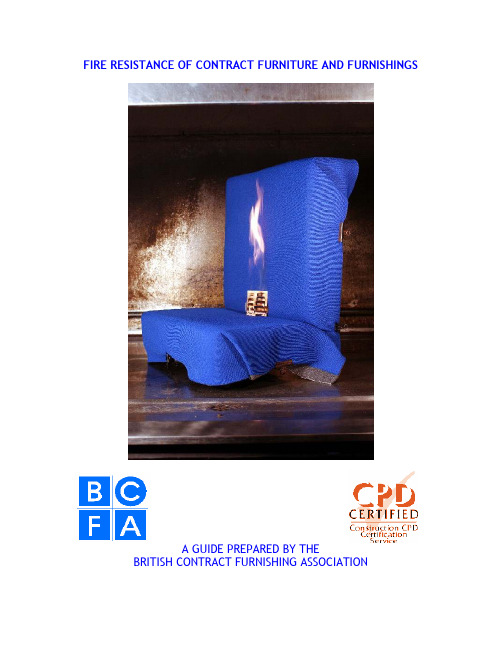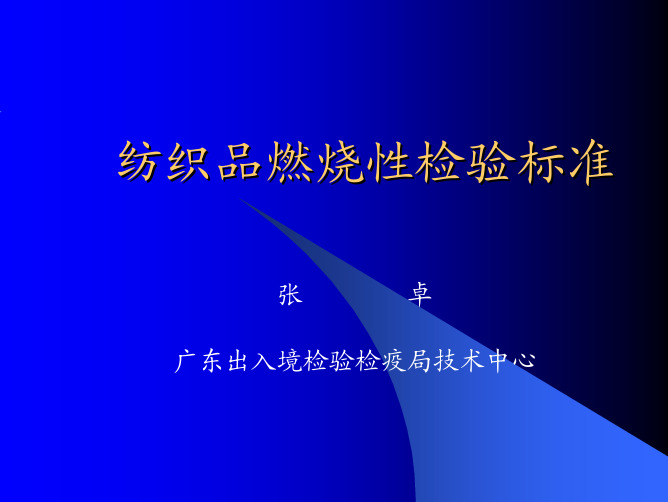BS7176,BS7177课件
- 格式:ppt
- 大小:233.00 KB
- 文档页数:15

不同国家阻燃面料的相关阻燃标准由于不同的国家对阻燃面料的阻燃标准要求不同,因此做国外贸易的生产厂家要严格按照购买商的国家标准来生产阻燃面料,以下列举几个国家阻燃面料的阻燃标准:中国阻燃标准GB8624-1997家具装饰布美国FMVSS302汽车装饰织物NFPA701窗帘FAR25-853飞机装饰织物CS191-51防护服澳大利亚AS1249.2(AS2755)儿童睡衣AS1441.13涂层织物AS2390.2毯子AS1530.2(AS2755)窗帘AS3744.2家具覆盖织物英国BS5722(BS5438)儿童睡衣BS5815.3(BS5438)床上用品BS5867.3(BS5438)窗帘BS6249.1B(BS5438)防护服BS6341(BS5438)床单及枕头BS7175(BS5852)家具覆盖织物BS7177(BS5807)床垫床基等法国NFG07-184防护服NFG92-501-505装饰织物德国DIN23320(DIN53906)防护服DIN66083(DIN54336-80)防护服DIN66084(DIN4102)装饰织物日本JISL1091防护服TCL1008-69飞机装饰织物JISD1201=FMVSS302汽车装饰织物英国阻燃标准BS7177(BS5807)适用于英国公共场所的家具及床垫等织物。
特别要求防火性能,测试方式严格。
火种分为0~7级八个火源,分别对于应低度、中度、高度和极高度危险四个防火等级。
BS7175适用于酒店宾馆、娱乐场所及其他人员密集场所的永久性防火标准。
测试要求通过Schedule4Part1及Schedule5Part1两种或更多的测试火种。
BS7176适用于家具覆盖织物,要求防火和耐水洗,测试时要求织物和填充物同时达Schedule4Part1、Schedule5Part1和烟密度、毒性等测试指标。
是比BS7175(BS5852)更为严格的一项衬垫座椅防火标准。

FIRE RESISTANCE OF CONTRACT FURNITURE AND FURNISHINGSA GUIDE PREPARED BY THEBRITISH CONTRACT FURNISHING ASSOCIATIONCONTRACT FURNITURE FIRE RESISTANCE REQUIREMENTSRequirements in the contract area are a voluntary standards regime but if specified, by a customer, become subject to Contract Law. Requirements are given by British Standards (BS) but test methods are a mixture of BS and European Standards (Norms) (EN). This is because of differences between UK law and other European national laws.The requirements standards are graded, that is they have more than one level to cater for different types of use, in some cases there is discretion as to which level can be chosen. If the customer does not specify the level required, you should always ask for clarification, the customer may be assuming a level or may be entirely ignorant. Where disputes have arisen in these circumstances, the supplier nearly always loses as they are deemed to have a responsibility to advise where the specification is not clear.It is not unknown for customers to ask for non fire-retardant products to save cost, you must not agree to this. Despite the fact that fire resistance is a voluntary regime, custom and practice dictates that the accepted standards should be adhered to, pleas that it is voluntary or that the customer said otherwise are exceedingly unlikely to provide a defence in court.It is well worth having a copy of the requirement standards for reference but there is no point in holding copies of the test methods standards as these are really for test laboratory use only.Upholstered Furniture and SeatingThe requirements are laid down in BS7176: 1995 Incorporating Amendment No. 1 and are for the testing of a composite of filling and cover. The normal requirements are Medium Hazard, which covers hotels, restaurants, pubs, bars, places of entertainment, hospitals, hostels and messes. Medium Hazard requires resistance to the ignition source specified in BS EN1021-1 (cigarette), BS EN1021-2 (match) and Ignition Source 5 (Crib 5) specified in BS5852.Some contract areas are classified Low Hazard by BS7176 and only need cigarette and match test. These are offices, schools, colleges, universities, museums and day centres. In practice, most customers will ask for Medium Hazard as a matter of course and most manufacturers supply to Medium Hazard as the norm.Depending on the volumes manufactured there are requirements for re-testing. For runs of less than 200, predictive testing can be used. This tests a fabric sample using a standardised filling. The fabric should still be re-tested every 20,000m. For runs of more than 200 units, re-testing should take place every 2,500 units or monthly.Products must be permanently and clearly labeled and BS7176 gives the specification for this.Note that the actual tests are to all intents and purposes the same as for the Domestic Furniture Regulations although the labeling is different. This is because the Domestic Furniture Regulations specifically reference BS5852. Since Amendment 1 to BS7176,furniture that has been demonstrated to meet the requirements of The Furniture and Furnishings (Fire) (Safety) Regulations 1988 shall be considered to satisfy the requirements for Low Hazard category of BS7176. This means that product that is certified to BS5852 is considered to meet BS7176 but not vice-versa. For companies that supply both domestic and contract markets, this saves the cost of dual testing.Mattresses, Divans and Bed BasesThe requirements are laid down in BS7177: 1996 Incorporating Amendment No. 1 and provides for the testing of a composite and for testing of individual fillings of different types. Mattresses, divans and bases can be tested on their own or as a total bed assembly where the bed coverings are known (the normal situation in the contract environment). Where the bedding is specified Section 3 of BS6807 provides the test method, where the bedding cannot be specified Section 2 of BS6807 is used. The difference is in the detailed positioning of the ignition sources. The normal requirements are Medium Hazard, which covers messes, day centers, hotels, hostels, old peoples’ homes, holiday camp chalets, boarding schools, residential schools and halls of residence. Medium Hazard requires resistance to the ignition sources specified in BS EN597-1 (cigarette), BS EN597-2 (match) and the Ignition Source 5 specified inBS6807 Section 2 or 3. Hotels, hostels and old peoples’ homes can also be High Hazard, in which case they have to meet resistance to ignition with Ignition Source 7of BS6807 Section 2 or 3 in place of Ignition Source 5. The level of hazard requiredwill be dependent on the features of individual premises and their usage. These ignition sources equate to the ignition sources of BS5852 and BS EN1021-1 & 2.Depending on the volumes manufactured there are requirements for re-testing. For production of less than 400 units per month, one unit should be tested every 6 months. For production of between 400 and 2,400 units per month, one unit should be tested per 2,400 and for production of more than 2,400 units per month, one per month.Products must be permanently and clearly labeled and BS7177 gives the specification for this.Bedcovers and PillowsBS7175: 1989 gives test methods for assessing the resistance to ignitions of bedcovers and pillows. It draws on BS5852 and BS6807 for ignition sources. Requirements arenot laid down but could be inferred from BS7177. The test results are expressed as a straight pass/fail against each ignition source.Fabrics for Curtains and DrapesThe requirements are laid down in BS5867: 1980. There are three performance requirements, expressed as Types A, B and C, for contract use Type B is the appropriate one. The test method is given in BS5438 and is for a small flame source applied to a vertical oriented sample, either to the face or to the bottom edge. Type B testing is carried out on 6 samples according to BS5438 but if one sample fails, a pass can still be gained if there are no failures on testing a further 6 samples.Textile Floor CoveringsThe requirements are laid down in BS5287: 1988 and are suitable for all textile floor coverings. The test method is given by BS4790, which simulates a small ignition source lying on the floor covering. For contract use an affected radius of less than 35mm is required. Note that there are three mounting methods: loose-laid, fully adhered and loose-laid with underlay; the results will only be valid if the floor covering is laid in the same way as the sample tested.Wall CoveringsWall coverings are a potentially difficult area and requirements would depend on the type (use) and size of space and the presence of automatic fire detection. In general terms concrete, brickwork, plasterboard, ceramic tiles, plaster and rendering, woodwool slab, thin vinyl and paper coverings on inorganic surfaces are acceptable everywhere including circulation spaces and escape routes. Timber, hardboard, blockboard, particleboard, heavy flock papers and flame retardant treated thermosetting plastics can be used in rooms but not on stairways and corridors that form escape routes. In rooms of area less than 4m² polystyrene wall and ceiling linings may also be used. The relevant standard is BS476 Part 7, covering surface spread of flame on vertical surfaces, this uses a gas fired radiation panel 900mm square as its heat source with the flame burning for 1 min. Up to 9 samples can be used to obtain 6 valid results. Class 3 is the requirement for small rooms and is met if the average spread of flame is limited to 265mm after 1.5 min and 710mm after 10 min. Class 1 is the requirement for other rooms and is met if the average spread of flame is limited to 165mm after 10 min. Circulation spaces and escape routes require Class 0, which is not BS476 but is found in Part B of Building Regulations. Partitions should meet, at least, the requirements of the space that they divide.Compliant construction products are readily available but furnishing materials are unlikely to have been tested. Careful thought should be given before changing a wall covering or using an unusual material. The advice of the local Fire Officer should be sought in any area where there is the slightest doubt as to suitability.WatchpointsThe main problems encountered are with imported fabrics and upholstery as most other countries don’t have ignition resistance requirements to UK levels. The issue is verifying any claims made by an overseas supplier. Verbal assurance is worthless, written assurance is better but you would be well advised to insist on copies of test certificates, note especially the date of issue in connection to re-testing (above). Be aware that there are forged certificates in circulation and that these are indistinguishable from the genuine article. If in doubt, the way to check is to call the test laboratory and have them confirm that they have issued that certificate, to that company, for that particular product. You should view with particular caution any products manufactured in the Far East and imported through a 3rd party company based in another EU country. Such arrangements are often a ploy to circumvent national safety requirements (not just furniture, these arrangements are found for a wide range of goods) by exploiting the EU “free passage of goods” policy.Special Requirements for the Public SectorThe public sector have some particular requirements, these are found in BS5815 although there can be departmental issued documents as well.BS5815In three parts this specifies performance requirements and construction for sheets, pillowslips, towels, napkins, counterpanes and quilt covers for use in the public sector. Part 3 is counterpanes and quilt covers. The flammability requirement called up is found in BS5438.The British Contract Furnishing Association is the leading trade association in the UKfor companies supplying furniture and furnishings into the contract area. The contract area comprises, offices, hotels, restaurants, bars, educational establishments, hospitals and healthcare establishments and some niche areas. The BCFA represents a sector worth around £2 billion annually.Project House, 25 West Wycombe Road, High Wycombe HP11 2LQ Tel: 01494 896790 Fax: 01494 896799 E: enquiries@。

各国不同的防火阻燃性纺织品的评价标准尽大局部的纺织材料是可燃的,即使通过阻燃技术处理也难以阻止纤维在火焰中燃烧。
但通过阻燃处理的纺织品会不同程度地落低燃烧速度或离开火源后能够迅速停止燃烧,因此阻燃是一个相对的概念。
在人们日常生活中,各种火险隐患无所不在。
为了减少由于纺织品易燃引起的火灾事故,减少由此造成的对人一辈子命和财产平安的危害,纺织品燃烧性能的测试受到了世界各国的高度关注。
针对纺织品的不同用途,世界各国制定的阻燃法规也已由飞机内饰纺织材料、地毯和建筑装潢材料逐渐扩大到睡衣、家具沙发套、床垫和室内装饰物等。
英国、美国、日本等国家还以法律形式规定:妇女、儿童、老年人、残疾人的服装以及睡衣必须是具有阻燃功能的,且须在产品上标明。
中国在这方面的立法和标准化工作也在不断加大力度。
评判标准评判织物的阻燃性能通常采纳两种标准:一是从织物的燃烧速率来进行评判。
即通过阻燃整理的面料按规定的方法与火焰接触一定的时刻,然后移往火焰,测定面料接着有焰燃烧的时刻和无焰燃烧的时刻,以及面料被损毁的程度。
有焰燃烧的时刻和无焰燃烧的时刻越短,被损毁的程度越低,那么表示面料的阻燃性能越好;反之,那么表示面料的阻燃性能不佳。
另一种是通过测定样品的氧指数(也称极限氧指数)来进行评判。
面料燃烧都需要氧气,氧指数LOI是样品燃烧所需氧气量的表述,故通过测定氧指数即可判定面料的阻燃性能。
氧指数越高那么讲明维持燃烧所需的氧气浓度越高,即表示越难燃烧。
该指数可用样品在氮、氧混合气体中维持烛状燃烧所需氧气的最小体积百分数来表示。
从理论上讲,纺织材料的氧指数只要大于21%(自然界空气中氧气的体积浓度),其在空气中就有自熄性。
依据氧指数的大小,通常将纺织品分为易燃(LOI<20%)、可燃(LOI=20%~26%)、难燃(LOI=26%~34%)和不燃(LOI>35%)四个等级。
事实上,几乎所有常规纺织材料(纤维)都属易燃或可燃的范围。



世界各国阻燃测试标准解析燃烧测试实验是目前很多的产品都需要进行的检测,不同的产品有着不同的燃烧检测要求,不同的国家同样有着不同的标准和要求,标准集团(香港)有限公司简单罗列了目前市场上常用的世界各国阻燃测试标准。
测试项目:●床褥●枕头●床具●衬垫家具●汽车用品●里布●面料●窗帘●防尘布●填充物料●毯子●幕布●玩具●魔术贴●防护类●塑料●工装●皮革●海绵●辅料等等。
国际阻燃测试标准汇总1.CALTB 116(成品家具香烟测试)2.CAL TB 1173.CAL TB 1214.CAL TB 1295.CAL TB 1336.CAL TB 6037.CAL TB 6048.16 CFR 16109.16 CFR 161510.16 CFR 161611.16 CFR 163012.16 CFR 163113.6 CFR 163214.16 CFR 163315.16 CFR 1500.4416.ASTM E 8417.ASTM D 123018.ASTM D 643119.ASTM D 654520.ASTM D 513221.ASTM D 437222.ASTM D415123.ASTM E 159024.ASTM E 135225.ASTM E 135326.ASTM E 153727.ASTM F 96328.ASTM F 195529.NFPA 70130.NFPA 70231.NFPA 70332.NFPA 26033.NFPA 26134.NFPA 26635.NFPA 26736.FAR 25.85337.CPAI 7538.CPAI 8439.FMVSS 30240.FTMS 590341.UL 9442.UFAC43.CS 191(防护服)英国标准44.BS AU 169A45.BS 456946.BS 479047.BS 528748.BS 543849.BS 5452(50次水洗)50.BS 568751.BS 5722(睡衣)52.BS 580753.BS 5815.3(BS5438)(床上用品)54.BS 585255.BS 5866(1.2.3)56.BS 586757.BS 6249.1B(BS5438)(防护服)58.BS 630759.BS 6431(BS 5438)(床单及枕头)60.BS 680761.BS 717562.BS 717663.BS 717764.BS 7837澳大利亚66.AS 2755(1.2.3)67.AS 1530(1.2)68.AS/NAS 4088.169.AS/NAS 3744(1.2.3)70.AS 1249.2(AS2755)(儿童睡衣)71.AS 1441.13(涂层织物)72.AS 2390.2欧盟标准74.EN 7175.EN 34076.EN 47077.EN 53178.EN 53279.EN 53380.EN 59781.EN 102182.EN 110383.EN186984.95/28 EEC(汽车内饰阻燃, 尺寸要求不同)85.EN ISO 12952ISO国际标准88.ISO 717689.ISO 694190.ISO 1004791.ISO 812492.ISO 9772(电器内用泡绵阻燃)93.ISO 3795 (汽车内饰阻燃, 尺寸要求不同)94.ISO 819195.ISO12952德国标准96.DIN 4102 B297.DIN 66084(DIN4102)(装饰织物)98.DIN 23320(DIN53906)(防护服)99.DIN 66083(DIN54336-80)(防护服)日本标准102.JIS D 1201(汽车内饰,尺寸要求不同) 103.JIS L 1091(防护服)104.TCL 1008-69(飞机装饰织物)中国标准1. GB 8624 B1 B22.GB 175913.GB 84104.GB 54555..GB 8965(阻燃防护服)ASTM D3014EN / AATCC / UFAC/ASTM / NFPA/UL /GB etc.。
各国不同的防火阻燃性纺织品的评价标准绝大部分的纺织材料是可燃的,即使通过阻燃技术处理也难以阻止纤维在火焰中燃烧。
但通过阻燃处理的纺织品会不同程度地降低燃烧速度或离开火源后能够迅速停止燃烧,因此阻燃是一个相对的概念。
在人们日常生活中,各种火险隐患无所不在。
为了减少由于纺织品易燃引起的火灾事故,减少由此造成的对人一辈子命和财产安全的危害,纺织品燃烧性能的测试受到了世界各国的高度关注。
针对纺织品的不同用途,世界各国制定的阻燃法规也已由飞机内饰纺织材料、地毯和建筑装潢材料逐步扩大到睡衣、家具沙发套、床垫和室内装饰物等。
英国、美国、日本等国家还以法律形式规定:妇女、儿童、老年人、残疾人的服装以及睡衣必须是具有阻燃功能的,且须在产品上标明。
中国在这方面的立法和标准化工作也在持续加大力度。
评判标准另一种是通过测定样品的氧指数(也称极限氧指数)来进行评判。
面料燃烧都需要氧气,氧指数LOI是样品燃烧所需氧气量的表述,故通过测定氧指数即可判定面料的阻燃性能。
氧指数越高则讲明坚持燃烧所需的氧气浓度越高,即表示越难燃烧。
该指数可用样品在氮、氧混合气体中保持烛状燃烧所需氧气的最小体积百分数来表示。
从理论上讲,纺织材料的氧指数只要大于21%(自然界空气中氧气的体积浓度),其在空气中就有自熄性。
按照氧指数的大小,通常将纺织品分为易燃(LOI<20%)、可燃(LOI=20%~26%)、难燃(LOI=26%~34%)和不燃(LOI>35%)四个等级。
事实上,几乎所有常规纺织材料(纤维)都属易燃或可燃的范畴。
测试方法纺织品燃烧测试方法因原理、设备和目的的不同而呈多样性。
各种测试方法的测试结果之间难以相互比较,实验结果仅能在一定程度上讲明试样燃烧性能的优劣。
燃烧实验方法要紧用来测试试样的燃烧广度(炭化面积和损毁长度)、续燃时刻和阴燃时刻。
按照试样与火焰的相对位置,可分为垂直法、倾斜法和水平法。
国际上对纺织材料的燃烧性能测试方法的标准化差不多相当全面和完善,包括ISO、ASTM、BS、JIS在内的国际和国外先进标准都各自有10余项有关的测试方法标准,中国也已制订并实施了10多项不同的测试方法标准,如:GB/T5454-1997《纺织品燃烧性能试验氧指数法》、GB/T5455-1997《纺织品燃烧性能试验垂直法》、GB/TF5456-1997《纺织品燃烧性能试验垂直方向火焰蔓延性能的测定》等。
美国四分制标准美国四分制标准是出口坯布或者印染布的外观质量的检验标准,具体规定如下:一、织物疵点评分标准:织物疵点按“四分制”(FOUR POINT SYSIEM)评分1、评分方法疵点在3寸或以下评一分疵点超过3英寸而到6英寸评二分疵点超过6英寸到9英寸评三分疵点超过9英寸评四分2、连续性疵点,每1码计四分:3、较大的疵点(有破洞等)不计大小,每1码计四分;4、横档、中边色、不对色、幅不足、幅不同、有皱、整理不良等,连续发生时,每1码计四分。
二、以平方码为单位的计算方法1、每匹布:(常用)总评分数×36×100 评分=码数×有效幅度(寸)100平方码2、每单货:(整批布)每码总分数×36×100 评分=总码数×有效幅度100平方码三、验收标准(以100平方码为基准)适用欧洲、美国、日本等国家。
每匹布1组15分/100平方码2组20分/100平方码3组25分/100平方码4组40分/100平方码5组60分/100平方码现通用标准是选用2组、3组、4-5组不用四、全面疵点的评分标准☆连续性疵点1、连续有规律性疵点,1码计四分2、连续性3码以上,作不合格品对待。
☆整幅疵点3、合格品内不允许有以下疵点存在:A.长度超过6英寸全幅疵点。
B.较细小的全幅疵点,100码内超过5处。
C.以100码为单位,每10码中严重疵点平均2处以上。
D.布头、布尾3码内有严重疵点或整幅疵点的。
E.在平放裁床时,有边绉、预缩皱、波浪皱、折皱、皱条等疵布。
☆幅宽4、每匹布最少测三次。
5、达不到加工要求幅宽,则计不合格,6、幅宽计算:整幅度:两布边之间距有效幅度:去除布边、针洞、无印花部分的幅宽。
7、对色:分色最多接常受3个LOT色,每LOT色最小码数为500码以上,每LOT色之间色差按AATCC 灰色卡4-5级。
8、每匹布中边、头尾色差不能低于4-5级。
9、工厂检验时,应取6英寸匹头,编号后留给客人。
阻燃面料,阻燃标准中国GB8624-1997 家具装饰布美国FMVSS 302 汽车装饰织物NFPA 701 窗帘FAR 25-853 飞机装饰织物CS 191-51 防护服澳大利亚AS1249.2(AS2755) 儿童睡衣AS1441.13 涂层织物AS2390.2 毯子AS1530.2(AS2755) 窗帘AS3744.2 家具覆盖织物英国BS5722(BS5438) 儿童睡衣BS5815.3(BS5438) 床上用品BS5867.3(BS5438) 窗帘BS6249.1B(BS5438) 防护服BS6341(BS5438) 床单及枕头BS7175(BS5852) 家具覆盖织物BS7177(BS5807) 床垫床基等法国NFG07-184 防护服NFG92-501-505 装饰织物德国DIN23320(DIN53906) 防护服DIN66083(DIN54336-80) 防护服DIN66084(DIN4102) 装饰织物日本JIS L1091 防护服TCL 1008-69 飞机装饰织物JISD1201=FMVSS 302 汽车装饰织物英国BS7177(BS5807)适用于英国公共场所的家具及床垫等织物。
特别要求防火性能,测试方式严格。
火种分为0~7级八个火源,分别对于应低度、中度、高度和极高度危险四个防火等级。
BS7175适用于酒店宾馆、娱乐场所及其他人员密集场所的永久性防火标准。
测试要求通过Schedule 4 Part 1及Schedule 5 Part 1两种或更多的测试火种。
BS7176适用于家具覆盖织物,要求防火和耐水洗,测试时要求织物和填充物同时达Schedule 4 Part 1、Schedule 5 Part 1和烟密度、毒性等测试指标。
是比BS7175(BS5852)更为严格的一项衬垫座椅防火标准。
BS5452适用于英国公共场所及所有进口家具中的床单及枕头类纺织品。
要求经过50次水洗或干洗后仍然能够有效防火。